All about Conversion Optimization in 2023
In this guide, Brandfirm breaks down everything you need to know, in uncomplicated terms, about conversion optimization in 2023. With this guide within reach, CRO is made simple.

After reading this article, you learned:
- What conversion optimization exactly is
- How to get more out of your current website visitors
- How to use Cialdini's 7 Persuasion Principles to your advantage
- How to motivate website visitors to convert using the BJ FOGG model
- How to analyze the right data
- What A/B testing is and how this exactly works
- What user testing is and how to use it efficiently
- Practical conversion optimization tips that you can use immediately
In this article
1. Introduction to conversion optimization
In this guide, you will find practical tips & tricks.
Before we get started, we will explain what CRO means.
In our first chapter, we will tackle the question: what is conversion optimization? We also dive deeper into Cialdini's 7 principles and MBTI personality types.
What is conversion optimization?
At Brandfirm, we define conversion optimization as a specialized method to increase the probability, frequency, and number of times a visitor converts on your website.
In other words: techniques that allow you to turn a visitor into a converting customer.
By applying conversion optimization, you’ll get more out of your current visitors.
As a result, you will bring in more leads and sales that will grow your business, and more often than not increase your turnover.
What is conversion?
Conversion can mean several things.
Arguably the clearest form of conversion is when a website visitor orders a product from an online store. But filling in a contact form, clicking through to other pages on a website, or downloading a free e-book can also be seen as a conversion.
These micro-conversions are very valuable because they help you get to know your target group and expand your customer database.
So the type of conversions we want to optimize looks different for each company.
For example, when you’re running an online store you want to sell as many products as possible, but when you provide customized services you want as many requests for quotes as possible.
What is CRO?
CRO stands for Conversion Rate Optimiszation.
It means you keep tweaking and testing your website on your target audience to increase the conversion rate.
This rate is a percentage that indicates what percentage of website visitors have purchased something from your business.
It is calculated as follows: you divide the number of conversions by the number of sessions per page.
The higher this percentage, the more conversions take place on your website.
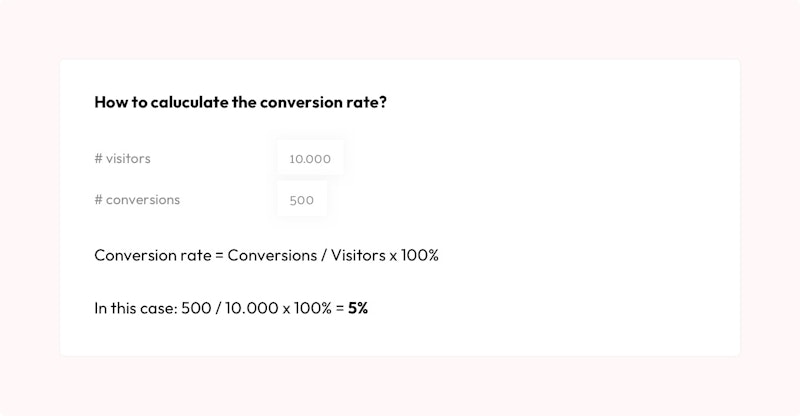
Cialdini's 7 Principles of Persuasion
If you are well-acquainted with the world of marketing, you have probably heard of Cialdini's 7 principles.
These are seven techniques you can use to lure and persuade your ideal customer to purchase something from your company.
These principles are applied in all facets of online marketing, so they can play a big role in increasing your conversion rate.
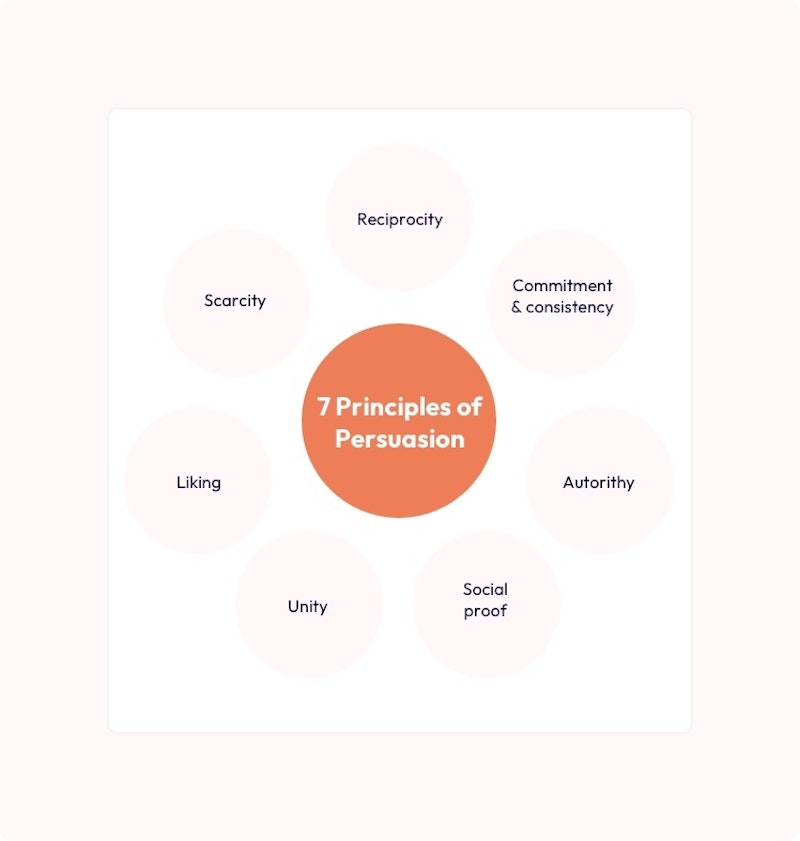
#1 Reciprocity: this is the principle of give and take. A free incentive can boost your conversion rate because you are giving something to your customer, making them feel like they should offer something in return. This often takes the form of a particular action or task on your website. For free incentives, think of a sample of a new product, a free e-book that goes with your offer, a no-strings-attached introductory meeting, a gift with the first order, or a 10% personal discount code when subscribing to a newsletter.
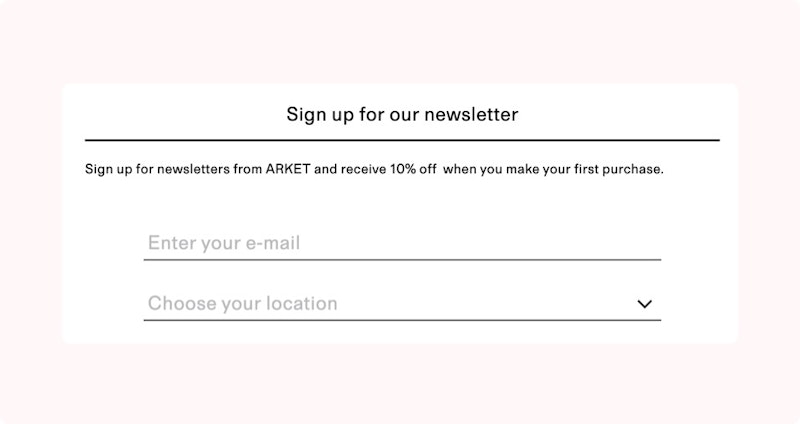
#2 Scarcity: It has been scientifically proven that people become greedy when there is a limited supply of a particular product. Examples include limited editions of products or a time restriction on a promotion or product. Take Booking.com, for instance. When you search for accommodation online, the phrase "8 people are currently looking at this" may pop up without warning. This makes you feel pressured to book quickly, as it would be a shame if the cottage were booked out. But even a special offer, only valid for a limited time, in combination with a countdown timer, helps the user decide to purchase something. Additional incentives are the words "don’t miss out", "exclusive, "while stock lasts" and "hurry up".

#3 Commitment and consistency: little by little you want to persuade the visitor to buy a product from your company. One way to do this is by regularly updating the visitor about what's on offer through a newsletter (about a new collection in your online shop, for example). This way you keep your visitor excited about your business. You can also get a potential customer to commit. This principle suggests that customers are reluctant to deviate from their commitment; after all, they want to be consistent with their point of view. When a potential customer has admitted on your website (for example, with a poll) that they think healthy living is important, they are more likely to purchase a product that promotes a healthier lifestyle
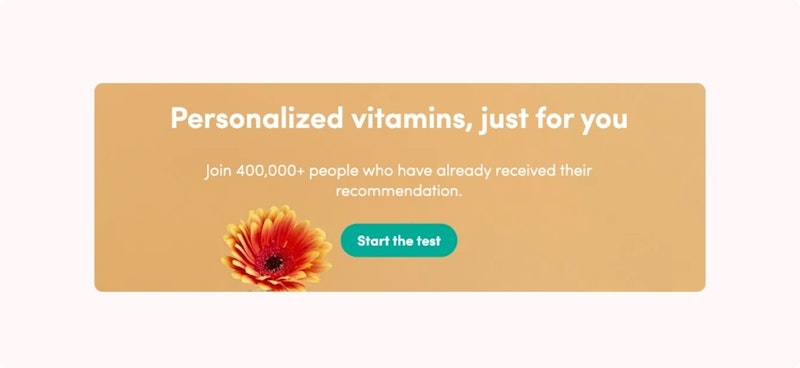
#4 Liking: visitors are more likely to convert when they feel a sense of personal connection to your business. We are more likely to say 'yes' to someone we like. As a business, you can appear more likable by adding an 'about us' page to your website and investing in friendly customer service. As a company, make sure you are active on social media. By showing your face there and offering a peek behind the scenes, you generate the interest of potential customers and come across as being more sympathetic. If your company gives something back to society, such as donating funds or engaging in charity, this can also have a boosting effect on conversions. Though this should not be your main goal.

#5 Authority: As a company, you want to claim expert status within your industry. After all, visitors are more likely to convert with a company that knows what they are talking about. You can claim this expert status by placing awards and seals of approval on your website, for example. Quotes from industry leaders that say something positive about your company also have a good influence on your authority. Finally, it is useful to include titles such as ‘expert’ and ‘author’ on your website. This way, you will be perceived as an expert. A good example of this is the Oral-B ads, where someone in a white doctor's coat tells you why their toothpaste is top-notch.

#6 Unity: by nature, humans have a huge urge to belong. In the days of hunters and gatherers, to survive, we needed to belong to a group. Nowadays, this is less relevant, but our instinct is still there. You can make use of it through conversion optimization, by making website visitors part of a group. Pick topics your group can identify with and tailor your offers accordingly. Or create a Facebook group in which you share unique content (and services) with this group of interested people. Expressing a feeling of community in your content can contribute to unity. Especially when it comes to getting repeat visitors to your platform (retention), this can be an appropriate technique.
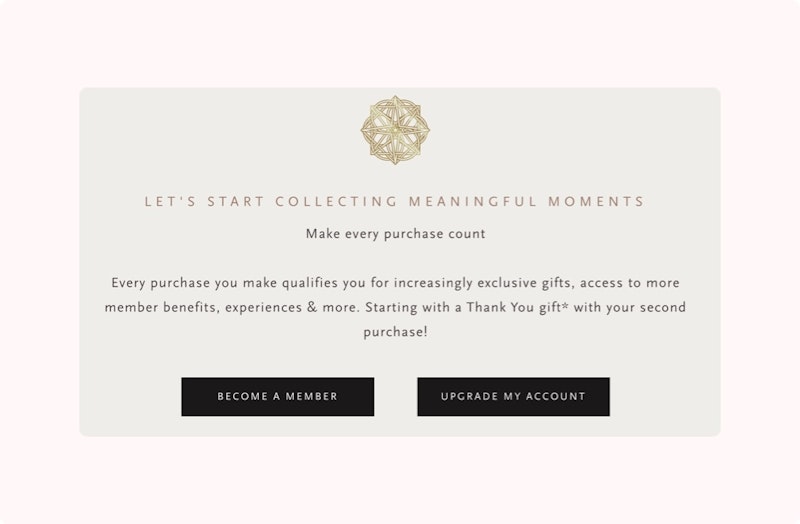
#7 Social proof: this last principle refers to the visitor looking for confirmation from others who have purchased something from your company before. The visitor wants to be sure that a product or service is the right choice, so they read reviews thoroughly. Positive reviews boost the visitor's trust, making them more likely to convert. In the same way, the number of followers or subscribers a company has is also a form of social proof. When all these followers already believe in your services and value, you are bound to be trustworthy. By applying social proof features, you take away doubt from the visitor.
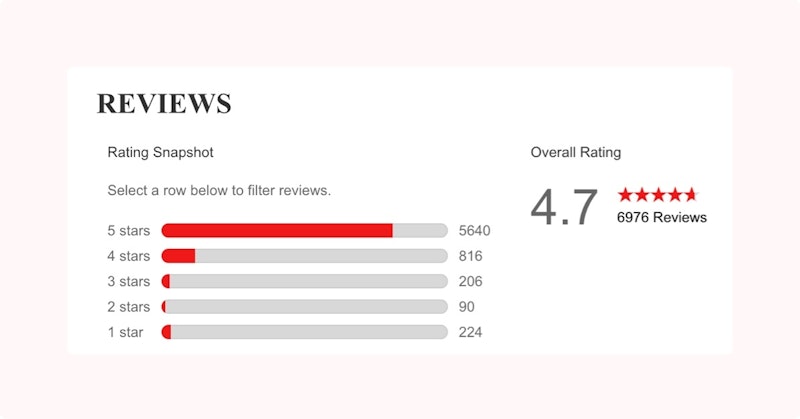
You can reflect these different persuasion techniques on your website in different ways.
You could, for instance, create a separate page for reviews and an 'about us' page.
Responding to scarcity can be done effectively through the visitor's shopping cart or on the product page.
Personality types according to the MBTI model
Not every visitor to your website is the same. That means that for conversion optimization, you need to cater to different personalities.
After all, every potential customer needs something different to convince them to purchase something from you.
To distinguish the different personality types, you can use the MBTI model (the Myers-Briggs Type Indicator).

This model divides website visitors into four different types that are tested on the following eight character traits: extroversion or introversion, sensing or intuition, thinking or feeling, and judging or perceiving.
#1 Competitive visitor: this visitor makes quick decisions based on facts. They decide by using their intuition and act quickly.
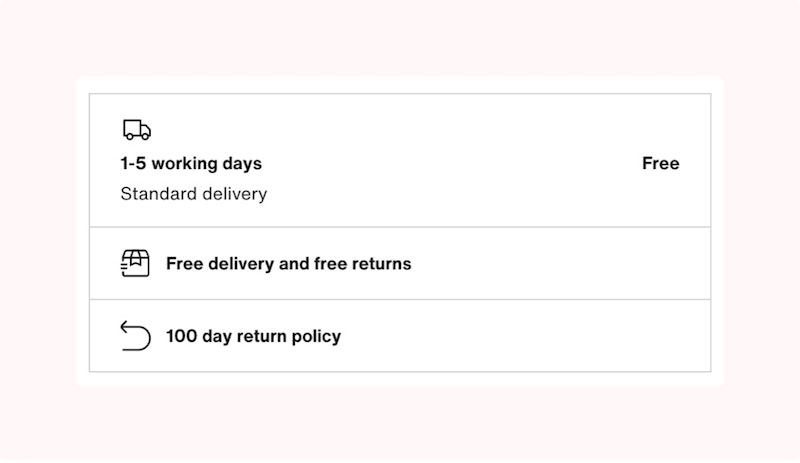
This is how you appeal to a competitive visitor: by displaying the most important facts as instantly and briefly as possible. Think of a list of the most important product specifications at the top of the page.
#2 Methodic visitor: this visitor focuses on the facts, makes well-considered decisions, and does not easily backtrack. They think everything through in great detail before a conversion takes place.
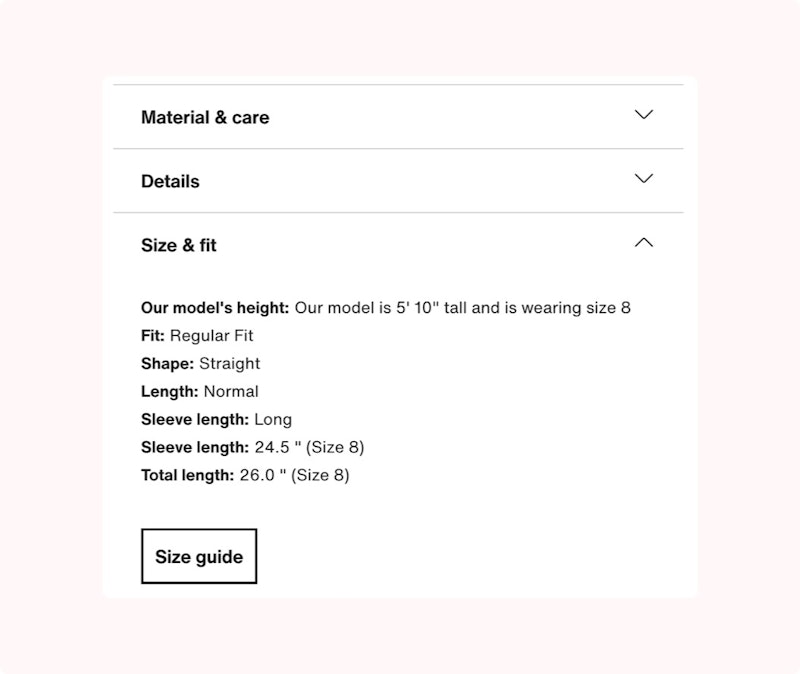
This is how you appeal to a methodic visitor: by also providing a summary of the product or service on the page. For example, think of a detailed description of the fit of a dress.
#3 Spontaneous visitor: this visitor judges quickly, but makes decisions based on intuition and emotions rather than looking at the facts. This visitor is particularly sensitive to discounts and special offers. They are also more likely to buy something when the product is in demand.
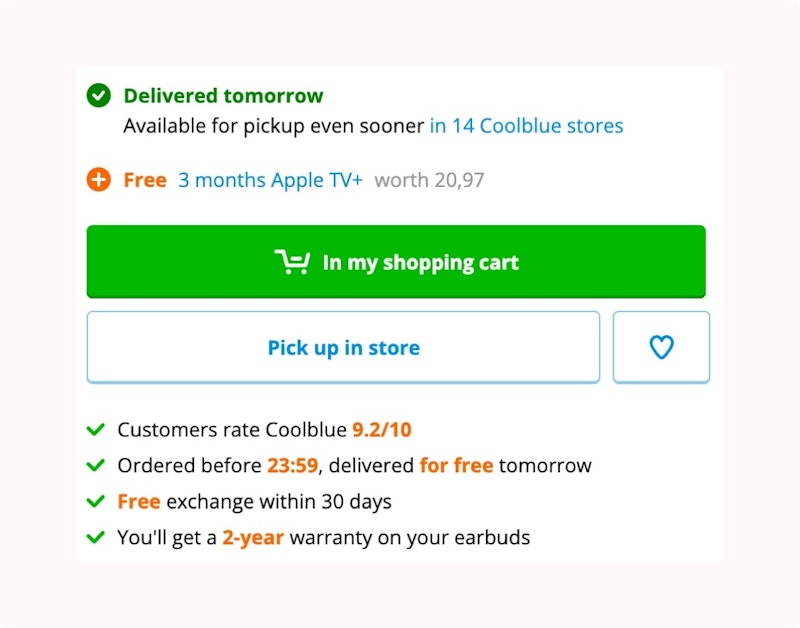
This is how you appeal to a spontaneous visitor: sprinkle in promotions such as free shipping, free returns, positive reviews, or the lowest price guarantee, etc. This way, you make the purchase all the more appealing.
#4 Humanistic visitor: this visitor also makes choices based on intuition, but does extensive research, unlike the spontaneous visitor. They will only buy something online if they are 100% sure of it, which makes it even more important that your company is seen as an expert.

This is how you appeal to a humanistic visitor: place positive reviews of your service or products on your website. A well-known certified label (such as the Dutch Thuiswinkelwaarborg) or award also stimulates this group to convert.
How to appeal to all these different personalities?
Of course, the trick is to appeal to all these different visitors at the same time.
A good overall balance is key. Make sure your services page or offer page incorporates the following elements:
- A clear and concise overview of the products and services you offer
- Positive reviews, business testimonials, and the placement of well-known logos or certified labels
- Promotional offers that suit your company
- A place for comprehensive information about your services, offers, or products
- The possibility to quickly contact you or leave the visitor's details in different ways, such as a contact form
You now know what your visitor needs to convert.
But just knowing what works for your visitors does not necessarily mean that conversion is optimized. For that, the visitor needs to be motivated and triggered.
We will explain exactly how this works in the next chapter.
Request our free CRO analysis
- Gain insight into opportunities for CRO
- This takes us at least 4 to 6 hours of work
2. Motivating visitors
You can encourage visitors to convert in different ways. In this chapter, we will tell you how to motivate your visitor to take the next step.
We do this by using the Fogg Behavior Model. This model by social scientist Brian Jeffrey Fogg can be used to turn website visitors into customers.
This requires three steps:
- motivation
- ability
- a trigger
It's all about influencing and changing behavior. But this doesn't happen overnight, as all three factors play an important role.
The formula is as follows:
Behavior (conversion) = Motivation x Ability x Trigger, all at the same time.
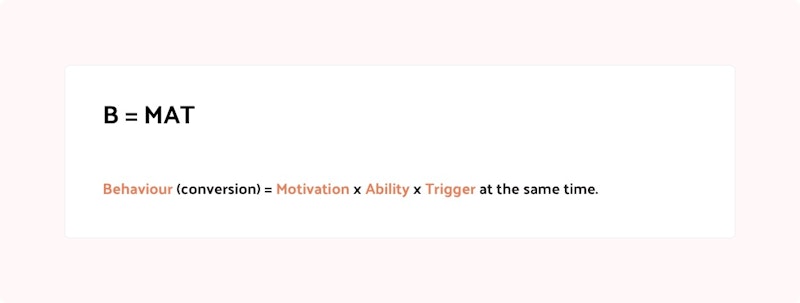
If your website does not have enough conversions, chances are you are missing one of these three factors at the moment.
The formula is successful when the visitor is motivated, the path to conversion is accessible (and easy), and the trigger occurs at the right time.
For instance: your company helps people live a healthy lifestyle. If customer A's motivation is to fit into a wedding dress at the end of the summer, chances are that they are willing to go to great lengths to achieve this goal. After all, motivation is high, so the road ahead (your healthier lifestyle plan) may be difficult. When that motivation is not there for customer B, because they do not have a clear reason to start living healthier, the healthier lifestyle plan should be more easily accessible than for customer A.
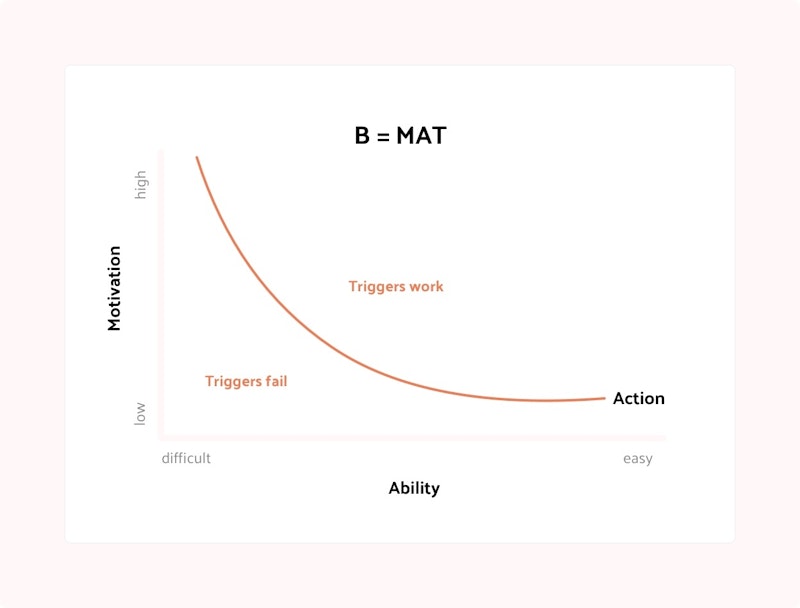
To further explain the Fogg Behavior Model, we will dive into its three different components: motivation, ability, and triggers.
Motivation
To optimize conversion, the visitor has to feel motivated regarding a particular service or product.
The greater the visitor’s motivation, the ‘harder’ you can make the offer.
By this, we mean that the price can be higher, for example, or the visitor can take more steps to purchase the product.
When a visitor is not that enthusiastic about your offer at all, they will not jump through hoops to convert.
You can positively influence visitor motivation in three ways:
- Sensation: respond to visitors' feelings by describing their obstacles and offering solutions to them
- Anticipation: capitalize on visitors' anticipation by making sure visitors don't want to miss out on something. For example, consider a temporary promotion that is about to end or a limited product offer
- Belonging: respond to visitors' desire to belong by encouraging them to recommend your offer to friends/family. For example, with a special discount code when you recommend your company to one more person
Ability
According to Dr Fogg, the founder of this method, as a business it is best to start by making your offer as accessible as possible.
To this end, remove all possible barriers for the visitor. According to Effecty, we humans - especially online - are impatient and we quickly drop out when a purchase is too complicated.
To provide the optimal user experience, it is important to think about the following components on your website:
- Does the website load fast enough? Look at this for both desktop and mobile
- Is it immediately clear to the visitor what action they need to take?
- Is there consideration for the four MBTI visitor types?
- Is it easy for the visitor to order something?
- Are there Call To Action (CTA) buttons on the homepage and do they stand out?
- Is the design user-friendly? Look at this for both desktop and mobile
According to the Fogg Behavior Model, six factors determine whether something is easy and accessible to the visitor:
#1 time: speaks to how much time a particular action takes. For example: if you have a full schedule, you don't have time to purchase a four-hour-a-week course. Or consider the delivery time of a product: you are more likely to order from a company that can deliver the product the very next day, instead of having to wait for two weeks
#2 money: when you have less to spend, services can sometimes be too expensive. For example: you can't buy products worth €1000 on minimum wage. As a business, you can respond to this by letting the visitor pay in installments, think of the fintech company Klarna.
#3 physical effort: speaks to how much physical effort you have to put into a service or product. For example: running every day for a healthy lifestyle may be too much effort for a customer who currently barely moves at all.
#4 mental effort: speaks to how much thought you have to put into a particular service or product. According to renowned psychologist Daniel Kahneman, humans want to think about their actions as little as possible. Example: when you have to enter your details into a contact form, we like it when this is automated.
#5 social deviance: to what extent does the product deviate from the social norm? For example: we are less likely to buy trousers in a bright color if people around us are only wearing black, white, or blue.
#6 routine: the closer your offer is to the visitor's routine, the sooner they will convert. For example: buying groceries at the same supermarket, even though other supermarkets might be cheaper.
Triggers
Triggers are the visitor's final push to purchase something.
It is important that the trigger is noticed, is linked to the visitor's target behavior, and is shown at the right time.
Without the right trigger, the visitor will not take appropriate action. So this is a final and important step in conversion optimization.
There are three types of triggers:
- Facilitators: you use this trigger when motivation is high but the offer is not accessible. Facilitators are messages that tell you that the behavior to convert is not as difficult as it seems. For instance: Order within five minutes!
- Sparks: you use this trigger when motivation is low, but the offer is very accessible. You want to emphasize the benefits your offer has to make the visitor more motivated. For instance: These are the 5 exclusive benefits you get when you sign up for our newsletter! Or: Get access to 5 exclusive deals when you subscribe to our newsletter!
- Signals: you use this trigger when motivation is just big enough and the offer is accessible. You only have to remind the visitor to take the last step (the conversion). This can be done with a targeted CTA. For example: View cart!
Motivating visitors on your website calls for three steps: motivation, ability, and triggers.
When you focus on these three factors on your website, the conversion optimization process will kick off.
But you’re not there yet, because for CRO, collecting and analyzing data is a must.
Receive our newsletter
- +5,000 entrepreneurs preceded you. We share our knowledge for free.
3. Collecting and analyzing data
To optimize conversion, you need to understand your company's data.
This can be done through many tools, but we will dive deeper into Google Analytics and Hotjar.
Through Google Analytics, for example, you can keep an eye on the channels through which visitors enter and on which page they exit.
You can also analyze the conversion rate, which is very important in CRO.
Start with Google Analytics
We recommend you start with Google Analytics.
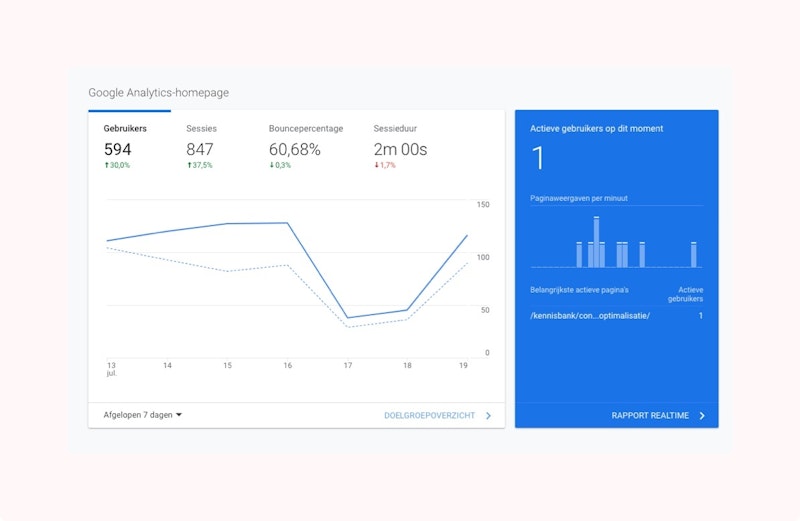
Especially if you have an online shop, Google Analytics allows you to see exactly what page people land on, how long they spend on that page, and when they leave again.
By understanding the data, you can discover what stops visitors from purchasing something. If you solve this, you will increase conversions.
Measuring the right data
In Google Analytics, there are various data measurement options. But how do you know which is best for your company's CRO?
To find out, determine in advance the KPIs (Key Performance Indicators) that suit your business. To start, it is smart to look at the following pillars:
- bounce rate
- add-to-cart rate
- exit rate
- conversion rate
Bounce rate
You want visitors to stick around on your website for as long as possible. A bounce means that your visitor visits only one page of your website before they leave. Something you want to avoid, of course. The bounce rate is the percentage of visitors that land on your site and leave immediately (or at least don't check out a second page). The higher the percentage, the fewer conversions your website has.
Request our free CRO analysis
- A free analysis worth 4 to 6 hours of work
- 87% of the companies we analyze miss out on sales

To do: You can reduce the bounce rate by creating a landing page that matches the message you are using to draw visitors to your website. If a link does not match a social media teaser, for example, visitors will not continue browsing your website.
Add to cart rate
This percentage is particularly interesting if you have an online shop. The add-to-cart rate is the percentage of visitors that have added at least one item to their shopping cart (this can be a product or a service). Google Analytics calculates this percentage by dividing the number of sessions where someone added something to their shopping cart by the total number of sessions. You want this percentage to be as high as possible.
You can also use Google Analytics' Enhanced eCommerce. This gives you insight into the number of add-to-carts, the number of visitors that go to their shopping cart, and the checkout funnel, among other things.
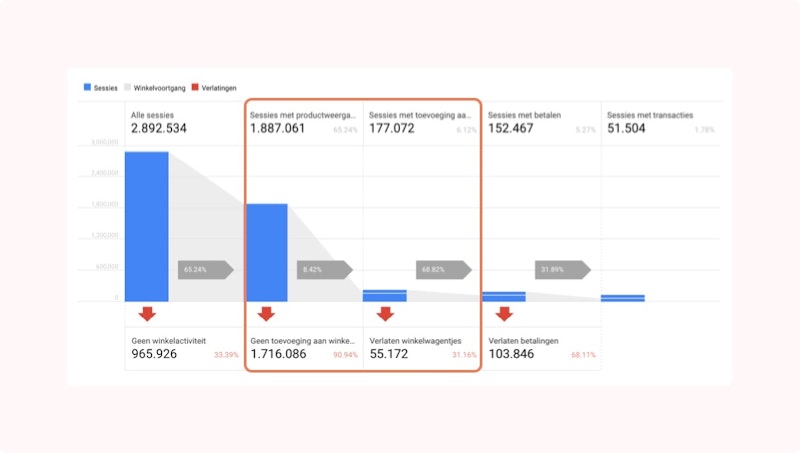
To do: To boost this number, you can, for example, make the ordering process more accessible, this can be done by testing features focused on service, delivery time, payment options, and reviews, among other things.
Exit rate
This percentage is the number of visitors exiting on a particular page. As a business, you want visitors to stick around on your pages for as long as possible and to eventually convert.
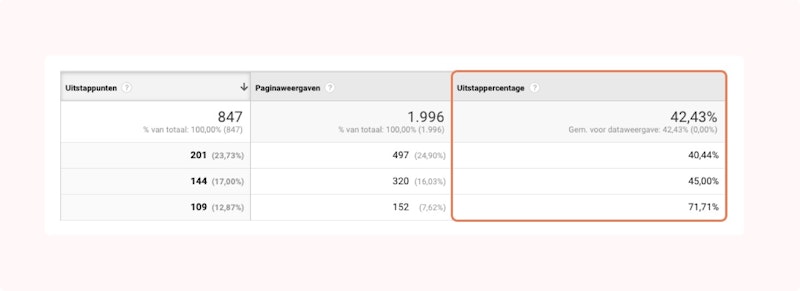
To do: You can encourage visitors to stick around by placing internal links in strategic places. This way, you guide the visitor through your website. In addition, you can place products similar to the ones you offer on a particular page under the banner 'Related items'. This way, you encourage visitors to look closer and stay on your website longer.
Conversion rate
This is, without doubt, an important percentage to keep an eye on for conversion optimization. After all, this rate reveals how many of your visitors convert. Make sure you compare figures for desktop and mobile users and pay attention to the different acquisition channels you use to reach customers. Want to analyze your target group even more fully? Then you can also create segments in Google Analytics that allow you to delve deeper into the target group.
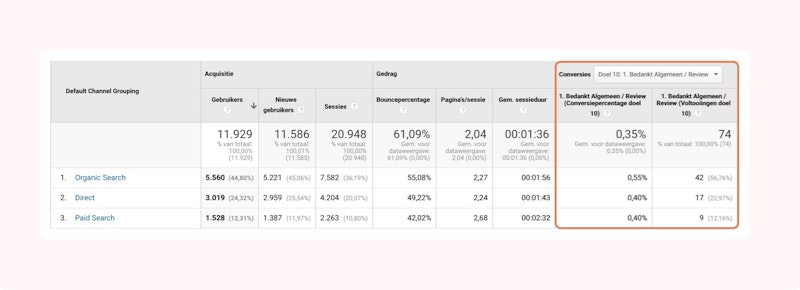
To do: You can enter this figure manually in Google Analytics. So you can add which type of conversion you think is important - filling in a contact form, for example. You can even enter and analyze offline conversions in Google Analytics, such as a shop visit or a phone call.
Additional data that is interesting to keep an eye on:
- Devices: this tells you whether your visitors are entering your website via their phones, desktops, or tablets. Notice that the majority land on your website via their phones? Then make sure your website is optimized for mobile users.
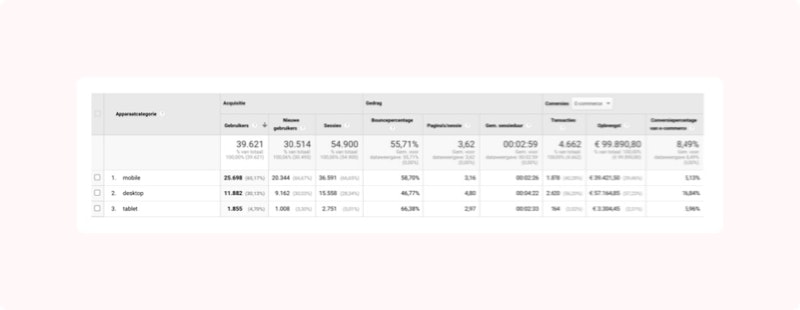
- Browsers: you can use this data to keep an eye on which browser most of your visitors are using to visit your site. Does the majority use Safari? Then make sure the website is fully optimized for this browser.
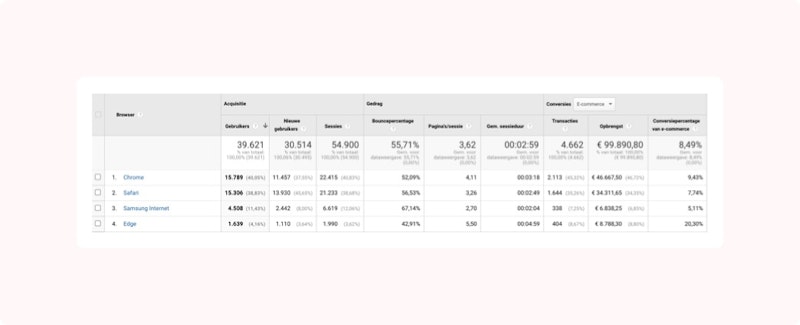
- Acquisition: in Google Analytics, you will find a dedicated report that measures your company's acquisition. Here you can quickly see where most traffic to your website comes from, how high your conversion rate is, and what happens with mobile traffic.
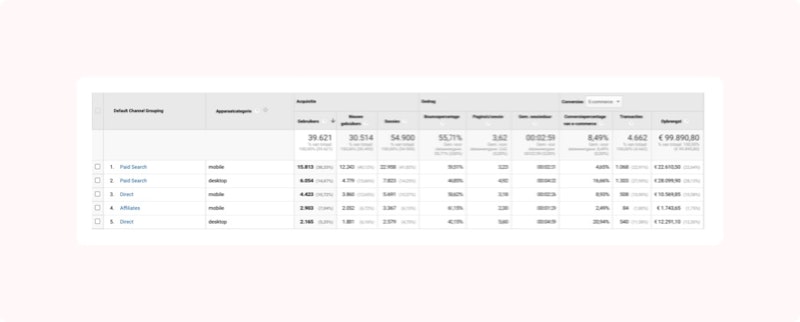
- Load time of pages: people are impatient. Therefore, your website's pages must load quickly so that you keep visitors on your website. The LCP (Largest Contentful Paint) should load within two and a half seconds. The LCP is the largest feature on your website and therefore determines a page's load time.
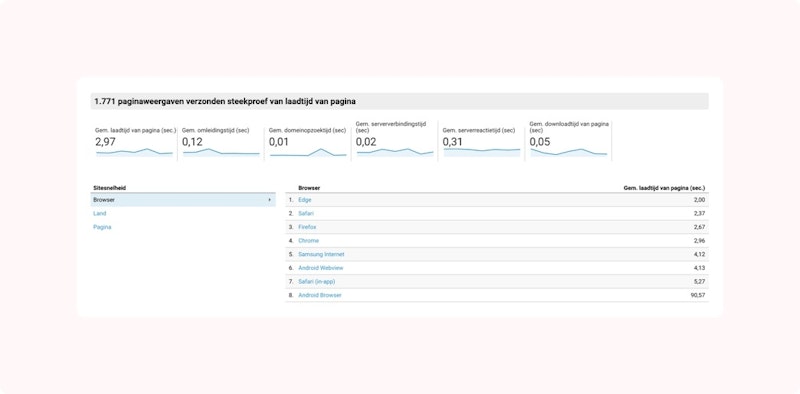
- Shopping basket failure rate: if you have an online shop (with services or products), it is useful to look at this percentage in Google Analytics. Visitors may have added a product or service to their shopping basket but dropped out. If this percentage is very high, see what you can do differently to the shopping basket to make the ordering process more user-friendly. This can be done using hypotheses, something we will explain further later in this guide.
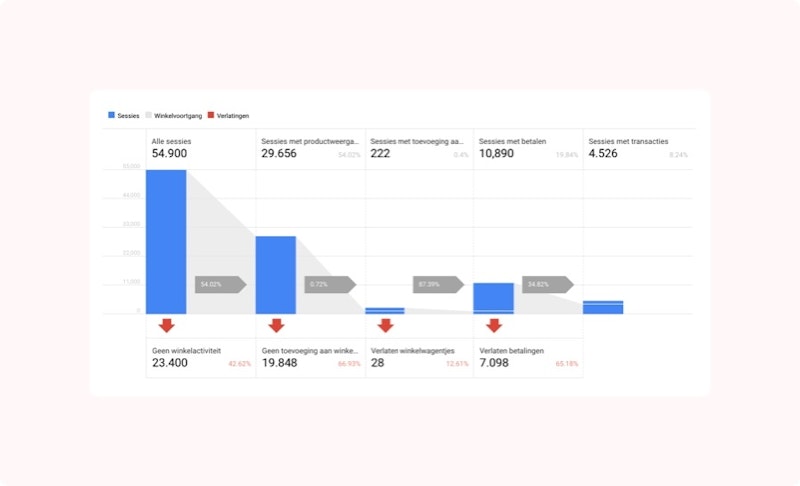
- Most visited pages: Tracking the most visited pages gives a lot of insight into visitors' needs and intentions. Use these insights to optimize underperforming pages. In addition, these insights can be taken into account when setting up email campaigns and ad strategies, among other things.
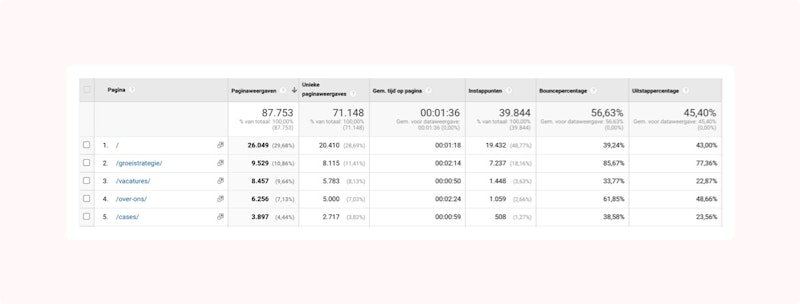
Bonus tip: look at data on a yearly, monthly, and quarterly basis to rule out seasonal trends.
Use Hotjar to gain visual insight
Apart from Google Analytics, you can also use Hotjar to gain insight into your visitors' behavior.
This tool has three major functions related to analyzing data:
- Heatmaps: you get to see the page in question with so-called red or "hot" areas. Those spots represent where visitors clicked, how they moved their cursor across the page, and how far down they scrolled. The hotter the area, the more visitors are clicking or interacting with it.

- Recordings: you get to see what visitors are doing with their cursor. This shows you how long they spend on a page and what time of day it was.
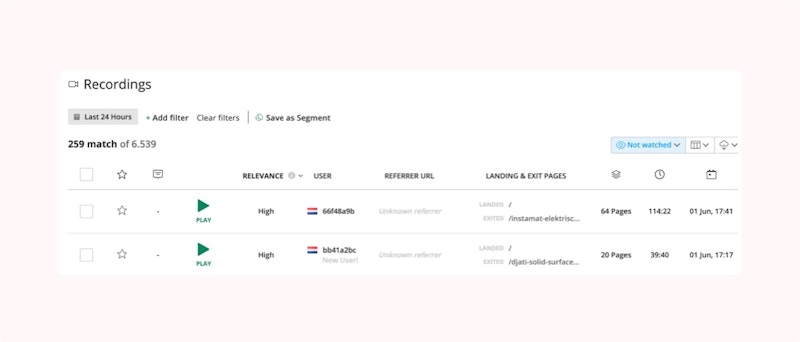
- Feedback: you get direct feedback from your website's visitors. This can be in the form of an easily accessible pop-up such as a poll, star rating, or a survey question.
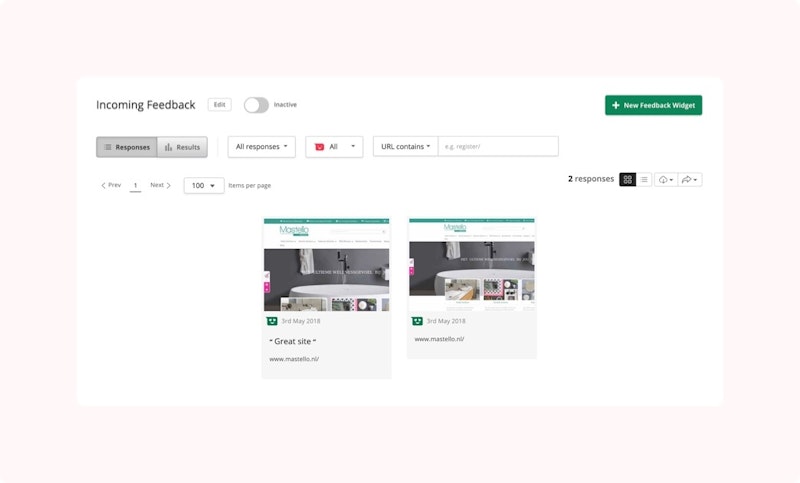
4. Setting up a hypothesis
When you start analyzing data for CRO, it is important to set up a hypothesis first. You do this based on insights from previous studies.
The hypothesis predicts a relationship between two factors, for example: the exit rate will go down when adding a 'Related items' section to a product.
The formula would be: if X, then Y will increase by 20%
But your hypothesis will not appear out of thin air, it is useful to do preliminary research first.
This is simply because the hypothesis is a prediction of what you expect to happen during an experiment (adding the 'Related items' section') and you can only make that prediction after you have done your research.
Say you want to lower your exit rate, the first thing you need to do is to look for the cause of the high exit rate. This is where the data you collected from Google Analytics comes into play.
Setting up a hypothesis works like this:
- First, gather as much data as possible as part of your preliminary research
- Evaluate the data (from Hotjar and Google Analytics, for example) and look for possible reasons behind the high exit rate
- Make a list of possible causes for the high exit rate
- Can you test, refute or confirm these causes?
- With which hypothesis can you make the most profit?
Example of a good hypothesis: If we add a 'Related items' section to the products/services page, visitors are more likely to stick around, which will reduce the exit rate of this page by x%.
Important questions to ask yourself to formulate a good hypothesis:
- Is the hypothesis formulated in such a way that you can measure it?
- Does the hypothesis have a dependent and independent variable?
- What variables are not in your hypothesis that could also be a possible cause?
After measuring and analyzing data and formulating a hypothesis, you can examine it using A/B testing. Find out more in the next chapter.
5. How does A/B testing work?
A/B testing is a common approach to investigate which feature causes the highest conversion rate.
What is A/B testing?
In A/B testing, you examine two variants on one page or part of a page. Half of your website visitors are shown variant A, while the other half are shown variant B.

By comparing conversion rates, you know which variant increases conversion. This is also known as split testing.
What should you pay attention to when doing A/B testing?
When you start A/B testing, you should keep the following aspects in mind:
- Know what you want to test: you can use the hypothesis from the previous chapter, for example
- Be specific about what you want to test: e.g. choosing a red CTA button or a green CTA button
- Test a single modification per experiment. If you test several things, you can never find out whether the shift in conversion rate is due to that particular adjustment
- Determine in advance which target group you want to include
- Determine the sample length (use https://vwo.com/tools/ab-test-duration-calculator/)
A/B testing different features
In A/B testing, you can test a lot of different features. These are the most common options:
- Titles: to see which title attracts more visitors to your website or which title ranks higher on Google
- CTA buttons: you can test whether where you place them has an effect, as well as text and color
- Text: you can test which text ensures more conversions or which text ranks higher on Google
- Emails/newsletters: you can play with the subject line of an email. But you can also test the content of the mail with A/B testing
- Images or links: you can measure whether changes on the homepage affect the conversion rate. Think of changing the header image or adjusting the menu
Choosing the right tool
If you want to get started with A/B testing, these tools are very handy to work with. They make setting up a test a lot easier.
- Google Optimize: this free tool is linked to your Google Analytics account, making it very easy to measure conversion rates. When you use Google Optimize in Google Chrome, you can very easily adjust features on your website to build the test. You can also indicate whether you want to test the entire website or just a specific page. You specify what you want to measure. For example: in the case of different CTA buttons, you measure the number of clicks on both buttons. Note: this tool slows down your website a little during testing.
- VWO: the Visual Website Optimizer tool makes it fairly easy to set up an A/B test. You can download the results and the tool is easy to use. The downside, however, is that this tool is relatively expensive and it does not automatically save your targeting.
- AB Tasty: this tool has other features besides A/B testing. For instance, you will find heat maps that help you keep an eye on how visitors are moving around on a particular page. It is a tool for beginners and very affordable.
- Optimizely: this tool is perhaps the most comprehensive tool for A/B testing. It has a special feature to only test mobile users, for instance. This is not a bad idea, as most visitors are usually mobile users. The downside, however, is that this tool is pricey.
Analyzing the results of A/B testing
With all tools, you gain insight into lots of data.
It is therefore important to be clear ahead of time what you want to look at. The number of clicks on a CTA button, for example, or the completion of a contact form.
When analyzing this data, look at the differences between the variants.
Do you notice your variant converts better? If so, investigate if there could be some other cause and do some research into what stands out.
In Analytics, see if you see differences in user groups or devices. Do you see that there are more clicks on the red button than on the green one? Then it may be a smart move to make this change on your website.
Conversion optimization is an ongoing process: in fact, you are only testing one component in each A/B test. So to increase conversions, you can keep testing, as there are plenty of features you can scrutinize.
6. How do you start user testing?
User testing (also called usability testing) measures how user-friendly your website is to visitors.
We already mentioned in Chapter 2 that it should be as easy as possible for a visitor to convert.
When there are as few obstacles as possible, visitors are more likely to buy a product. With user testing, you examine possible obstacles.
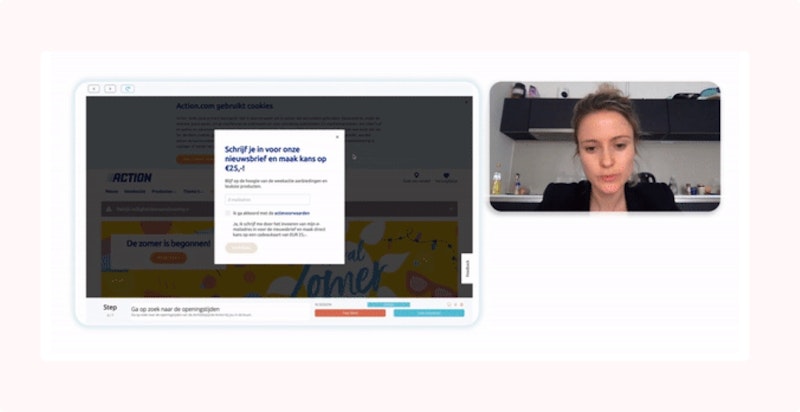
This is an intensive test that takes a lot of time and effort, but it pays for itself. Because if you know what obstacles users encounter on your website, you can remove them and optimize conversion as a result.
Types of user testing:
- In a lab: you invite users who use your website for you and offer feedback. You film the process
- Remotely: users go through the test remotely (their behavior is filmed and analyzed from a distance)
- With a moderator: the test is guided (remotely or face to face) by a moderator who asks targeted questions to the user
- Without a moderator: you read the obstacles based on the user's cursor movements and the video and audio recordings made
Here's how you start user testing:
#1 Make a plan: what are the hypotheses you want to test?
#2 Choose the type of user testing you want to carry out
#3 Determine your ideal target group
#4 Run the tests (remotely or in a lab)
#5 Analyze the results
#5 Write a report with the findings of the user tests. This also contains a roadmap of actions you can take to make your website more user-friendly
#6 Wondering if all these changes are having an effect? Then schedule another user test after some time to have the website analyzed again
7. Conclusion
This guide explained how to apply conversion optimization in a wide variety of ways. Below, we have listed the most important lessons from this CRO guide.
- You know how to respond to the user. For instance, you know that a free incentive increases conversion and that your conversion rate is higher when you portray your company as an authority. Likewise, users are more likely to buy when a product or service is scarce, when they find you likable, or are part of a group.
- You know how to capitalize on the four different MBTI personality types. You know how to increase conversion for the competitive visitor, methodic visitor, spontaneous visitor, and humanistic visitor.
- You know that conversion requires motivation, an accessible offer, and triggers. So not only do you need to motivate the user to purchase something, but you also need to make the ordering process as simple as possible and give the user a final push with an appropriate trigger.
- You know how to measure CRO in Google Analytics. Key KPIs include bounce rate, add-to-cart rate, exit rate, and conversion rate.
- You know how to formulate a hypothesis. You can use this hypothesis when running A/B tests to optimize conversion rates.
- You know that you can use A/B testing to investigate which page or feature results in a higher conversion rate. This lets you optimize lots of features, such as titles and CTA buttons.
- You know that user testing allows you to measure how user-friendly your website is. This enables you to make your website as accessible as possible to the user and increase conversion.
We are curious about your insights after reading this guide. Will you start A/B testing right away or will you start user testing first? Let us know by commenting below this post.
These are the 5 conversion optimization trends in 2023:
[1] Mobile first. Website visitors will mainly visit your website via their phones. It will therefore become even more important to optimize your website for mobile users in 2023.
[2] A/B testing is growing in importance. With so much on offer online, it will become even more important in 2023 to optimize your website as much as possible, so that you are prompting users to convert. How to go about this conversion optimization in practical terms is something you investigate with A/B testing.
[3] More in-depth data analysis. There is more and more data that you can analyze for CRO, but you need to know what that data means. So in 2023, focus even more on how to analyze data effectively. After all, all this data has the potential to increase conversions, but you need to know what you're looking at.
[4] The more user-friendly, the better. It's not just the user who judges you when your website is not user-friendly; by 2023, so will Google. The search engine now includes load time, searchability, and accessibility in its assessment of your website.
[5] Focus on customization. Customized landing pages are becoming more important in 2023. For example, when a user is searching for 'books on entrepreneurship' in your online shop, it pays to offer more of this type of product on their landing page, under the guise of: 'You might also like'. Smart technology can ensure that the next time that visitor comes to your website, the first thing they see is books about entrepreneurship instead of all the other books you sell.
Need help from a digital agency Amsterdam? Do not hesitate to contact us or request our free analysis.
Request our free CRO analysis.
- A free analysis worth 4 to 6 hours of work
- Clear custom-made CRO strategy
- 87% of the companies we analyze miss out on sales

